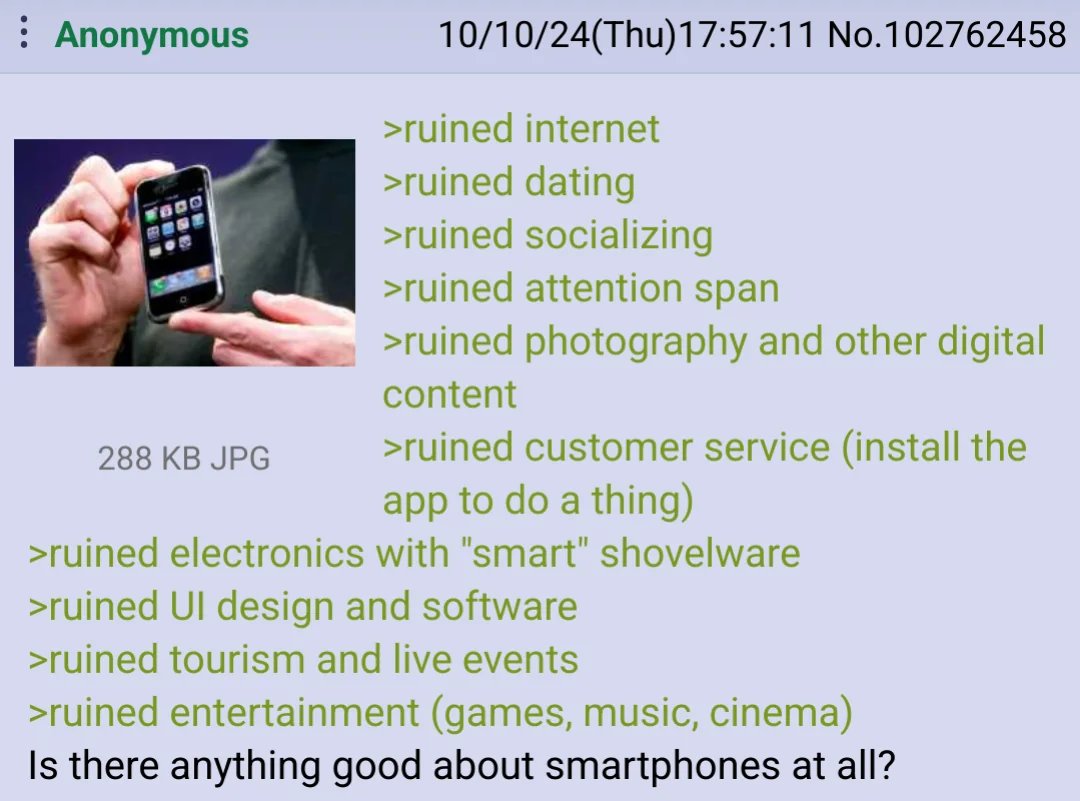this post was submitted on 20 Dec 2024
794 points (95.3% liked)
Greentext
5324 readers
1384 users here now
This is a place to share greentexts and witness the confounding life of Anon. If you're new to the Greentext community, think of it as a sort of zoo with Anon as the main attraction.
Be warned:
- Anon is often crazy.
- Anon is often depressed.
- Anon frequently shares thoughts that are immature, offensive, or incomprehensible.
If you find yourself getting angry (or god forbid, agreeing) with something Anon has said, you might be doing it wrong.
founded 1 year ago
MODERATORS
you are viewing a single comment's thread
view the rest of the comments
view the rest of the comments

smartphone manufacturers have almost no common standards, they are made to be bought and then disposed of instead of upgrading the specs
it's impossible to do stuff like upgrading ram which would be very easy on a computer, and every smartphone has a different cpu
companies are doing their best to keep the open source guys out of the game, which in my opinion would solve a lot of the issues if this weren't the case
I want a smartphone without ios or android but just plain linux, which should be upgradable and durable, possibly with open source firmware and that kind of stuff
You want a Framework laptop
That shit is not going to fit in your pocket
I'd argue Fairphones are pretty close although I'd probably go with a custom FOSS rom
the thing I don't like about fairphone, just like any other phone, is that upgradability is still impossible. I wasn't able to find any information about it when I checked, which is an indication that it's not possible, otherwise they would probably use it as a marketing point
I think the focus on fairphone is more on sustainability and repairability than upgradability
maybe it'll become possible with a future fairphone, or the mikrophone project, or another group
Don't worry! RAM is not upgradable on a lot of laptops now as well"!
Or storage if you're a Mac owner.
Both if you're a mac owner actually! I'm pretty sure the only user replaceable components are the screen and battery.
You can still replace the battery? They're slacking.
I mean I use a fairphone with /e/OS from Murena. This solves the issue of open source and upgradability/replacability mostly for me. I like the idea of bare linux phones but the hardware and software is just not there yet. I used an iPhone before that and while I miss some aspects of apple hardware I am really happy to be able to just replace parts without this tremendous glue they put in their phone and like 20 different screws and steps to replace one part. Besides some minor inconveniences the switch was definitely the right move!
I hate how /e/OS's 'BlissLauncher' doesn't let you leave an empty space between icons on the homescreen. I don't know whether switching to a different launcher will break /e/OS's widgets etc, and it bugs me just little enough to ignore it. The worst thing is that because you can't leave gaps (unless you leave the bottom row partially blank, which is dumb because that's the most important row), moving any app requires swapping it with another, which requires a minimum of three app-drags. In practice four, because draggin one app onto another will turn the icon into a folder with the two apps in them, so you'll have to open the folder and drag em both out.
I hate it so much. Why can't they just make a normal homescreen?
I switched to a different launcher a while ago. The one I use is Kvaesitso. It also has a widget integration and relies more on search although I can still pin Apps I want. I believe most alternate Launchers have their own Widget integration in a way so I'd recommend you try that
From my experience, all the linux for mobile distros I've tried on my Pinephone were a really bad experience, with a lot of issues. But the option is there, and while it wasnt reliable enough to use as a daily phone, I still carry it in the bag with a dock and Kali, which sometimes can get useful during pentesting.
Maybe a flatpak repo with mobile-first software?
The problem is the chipsets, which include the radio. They have their own proprietary code, including some built in firmware. Along with things like roaming, negotiating frequencies, requesting MMS downloads and other niggly details, you have stuff like handling sim cards, emergency services modes, and public alerts. All of which I've heard are lightly documented and a pain to work with... It's a lot of compatibility layers built up over the years
You can get a Linux phone today, the consensus just seems to be it's not ready as a primary phone